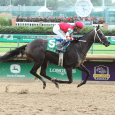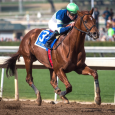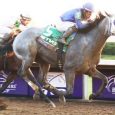By Maryjean Wall
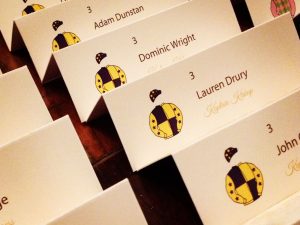
Horse racing weeding. Photo Courtesy of Karen Grace, Juggling Grace.
Autumn is the homestretch run in racing, a season when the focus narrows to the major stakes races such as the Breeders’ Cup to help determine season championships. Consequently, racing at the major tracks is big in the news even as the leaves change into fall colors. On a far different level, I am reminded of what was evolving at two minor-league tracks, the former River Downs in Cincinnati and Latonia, across the Ohio River in Kentucky, when autumn replaced summer some 40 years ago.
It was at that time that Harry C. Miller, 62 then, realized he could never live without Charlotte Kookendorfer at his side. She was 51 and a widow; he was a widower. The match seemed made in racetrack heaven, for the pair never lacked a common conversation topic: horses. Charlotte worked as a groom and also owned two thoroughbreds. Harry was a former jockey and exercise rider who said he’d galloped Man o’ War on occasion (most likely on the farm) before the old stud died in 1947. Harry was gyping around, as we used to say of small-time horsemen, trying to earn a living with a few cheap steeds. Then he met his lovely Charlotte. He knew she was the one.
Charlotte was only beginning to recover from the death of her husband, Everett Kookendorfer the previous year, in 1977 when the minor circuit had taken the horses to River Downs. Charlotte, with the help of the track chaplain, the Rev. Norman Evans, had arranged for a spectacular sendoff for Everett in a manner that only racetrackers could relate to. She held her husband’s memorial in the track’s test barn, the facility where the state takes blood and urine samples from winning horses and sometimes from losing favorites whenever the stewards deem them appropriate candidates to test for illegal drugs.
In those days racetrackers still referred to the test barn as the “spit box,” a holdover from earlier in the century when horses gave up only their saliva. Blood tests had yet to be invented for horses. Hence, the “spit barn,” an apropos appellation if you can picture horse spit flying all over with the high-minded purpose of upholding the sport’s honesty and good name.
Charlotte and the Rev. Evans put out the word that Everett’s memorial service would take place prior to the afternoon’s races on one hot, muggy afternoon. So here we all were, gathered by the river Ohio in the spit box, staring at Everett’s ashes in a cardboard box set atop a 50-gallon metal drum that might or might not have held murderous chemicals. Rev. Evans spoke some words about Everett, said the usual prayers over the cremated remains, and concluded with a “Godspeed” that turned us all loose in time for the first race.
Charlotte was not to be lonely for long. Harry’s wife had died a year before Everett went, so when Harry and Charlotte began to notice each other in a romantic way, they were both free of entanglements. In fact, they had planned to marry in 1977 until Harry got cold feet. Literally. They had to cancel the ceremony after Harry suffered frostbite on both feet. He nearly lost his limbs.
This happened when Harry had been trying to catch two horses on his farm during bitterly cold winter weather. One of the horses came willingly. The other did not and, blinded by the snow, ran into a tree and dropped dead. For his efforts, Harry had one dead horse and frostbite.
“They wanted to take one off at the ankle and the other off at the knee,” he told me about his legs. “But they didn’t, thank the Lord and my bride.”
Harry said he probably would have lost his limbs if Charlotte hadn’t been there to care for him. She bathed his feet three times a day in hot water and Ivory soap. Wonder of wonders, her Ivory soap ministrations saved Harry.
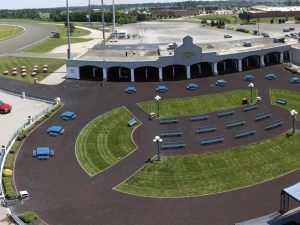
Turfway Park-Photo Courtesy of turfway.com
And so, in the fall of 1977 they began to plan their wedding day. The event was set for early February 1978 when the horses would be running at Latonia (now Turfway Park). As the day approached, Charlotte saw to final preparations. The ceremony was to be held inside the receiving barn, the place where horses shipping in for the evening’s races were stabled. This way, anyone arriving with a horse for that night’s program could attend the wedding before the races started.
Bales of straw were set up to resemble an altar and pews. Horses’ heads were sticking out of stalls as the animals watched this unexpected commotion with great interest. I remember how cold we all were: shivering through the marriage vows as we sat in those straw pews. You could see your breath because it froze in front of your face. Six jockeys dressed in racing colors lined each side of the altar. Two horses were supposed to stand up at the altar but they had to be circled at a walk in the rear of the “church” because they would not stand still.
The groom made his entrance attired in a western outfit that he used to wear when leading parades through Cincinnati on a Palomino horse he said was a full-brother to Roy Rogers’ Trigger. He talked about another horse he’d once had that won 24 out of 25 races. Unfortunately for the horse it suffered from a pinched nerve behind and could not run unless someone cranked its tail much in the way you would wind up an antique automobile. (I am not making this up).
The bride wore a long, plain dress. I believe she had to cover herself in a coat because it was so cold.
Mercifully, considering the extreme weather, the ceremony was over quickly. The guests retired to a reception in the track kitchen where peanuts and popcorn were served.
The rest of us were off to the races, having witnessed something in small-time racing that no one at the major tracks could ever claim to see.

